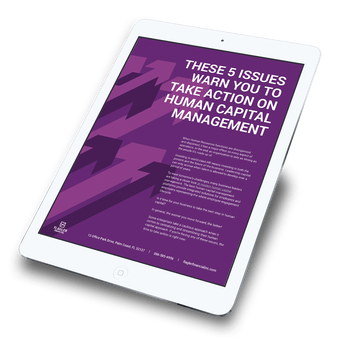To meet tomorrow’s challenges, many business leaders are taking a closer look at modern human capital management. The best human capital management platforms provide integrated solutions for employees and employers representing the whole employee engagement lifecycle.
Is it time for your business to take the next step in human capital?
In general, the sooner you move forward, the better!
Some enterprises take a cautious approach when it comes to centralizing and streamlining their human capital approach. If you’re facing any of these issues, the time to take action is right now:
1. Negative Trends In Employee Turnover
Employee turnover is one of the biggest signals that something is wrong in the HR landscape. Narrow turnover within a team or department can point to issues with a single manager, but a widespread trend suggests poor morale. This can be addressed by aligning your health benefits, retirement, and compensation with the market and instituting retention-focused programs.
2. Fragmented Or Unclear Business Culture
HR professionals often serve as the vanguards of the company culture. For a results-focused culture of success to exist, senior executives must define it at the top. The leadership team can define company culture in terms of values and turn those values over to HR and line leaders to translate into practice, but culture should be reflected in onboarding practices.
3. Growth In Recruitment Cost Or Time
Some organizations will naturally face greater difficulty than others when it comes to filling key positions: For example, organizations that rely on staffing with the latest IT, AI, or programming experts. For these organizations, long-term retention is more cost-effective than talent searches. Such organizations can attract excellent team members with integrated talent development.
4. Remote Workforce Transformation
More enterprises are exploring a mixed or remote workforce. A remote workforce substantially reduces capital and maintenance costs arising from office space. Many other costs can also be managed or eliminated. However, HR must be even more proactive in establishing standards, setting the tone, and championing the organization’s values.
5. Subtle Signs Of Workforce Issues
Problems with the workforce can be very subtle. You may need to use several methods, including employee surveys and longitudinal trend comparisons, to uncover them. For example, increased absenteeism can indicate falling morale. But so can things you might not monitor now, such as growth in frequency of employee sickness and showing up to work ill more often.
Flagler Financial Can Make Best-In-Class Human Capital Management Simple
The definition of human capital management has expanded to include every touch point in the employee lifecycle. Flager Financial empowers you with solutions that will allow your team or Chief People Officer to orchestrate HR easily in this fast-paced new world.
Flagler Financial’s proprietary solution has been built from the ground up with the needs of employers like you in mind. You can standup or modify your processes in benefits, onboarding, and training with the click of a mouse through our simple, intuitive interface.
Contact us today to learn more.
